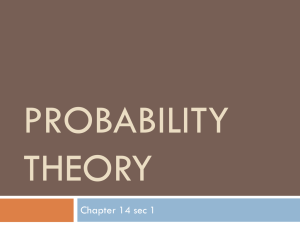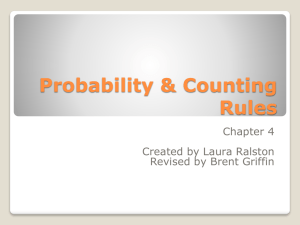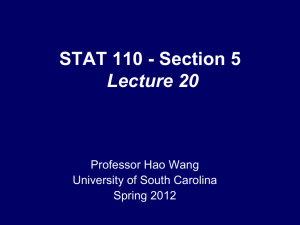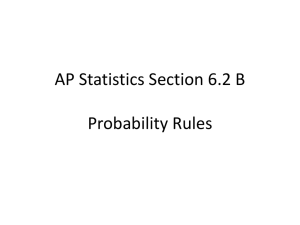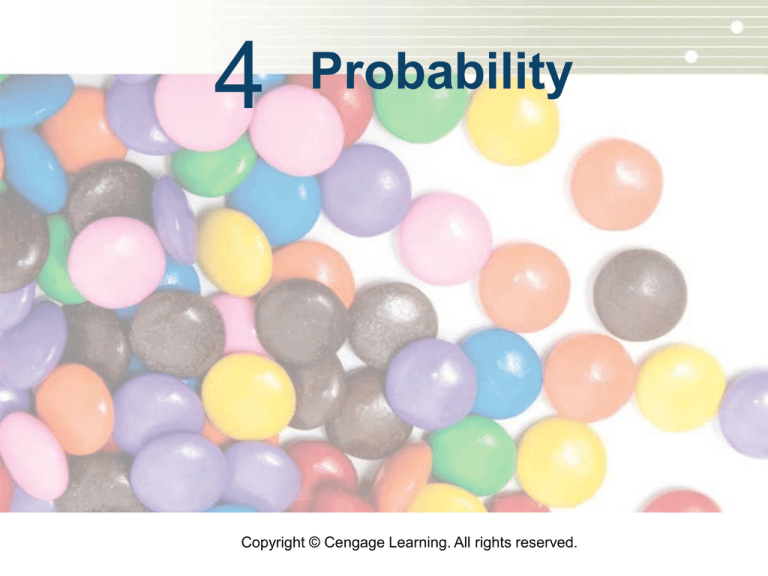
4
Probability
Copyright © Cengage Learning. All rights reserved.
4.1
Probability of Events
Copyright © Cengage Learning. All rights reserved.
Probability of Events
We are now ready to define what is meant by probability.
Specifically, we talk about “the probability of an event” as
the relative frequency with which that event can be
expected to occur.
The probability of an event may be obtained in three
different ways:
(1) empirically,
(2) theoretically, and
(3) subjectively.
3
Probability of Events
The empirical method was just illustrated by the M&M’s and
their percentages and might be called experimental or
empirical probability.
This probability is the observed relative frequency with
which an event occurs.
In the M&M example, we observed that 151 of the 692
M&M’s were blue.
The observed empirical probability for the occurrence of
blue is 151/692, or 0.218.
4
Probability of Events
The value assigned to the probability of event A as a result
of experimentation can be found by means of the formula:
Empirical (Observed) Probability P (A)
In words:
In algebra:
(4.1)
5
Probability of Events
The theoretical method for obtaining the probability of an
event uses a sample space.
A sample space is a listing of all possible outcomes from
the experiment being considered (denoted by the capital
letter S).
When this method is used, the sample space must contain
equally likely sample points.
For example, the sample space for the rolling of one die is
S = {1, 2, 3, 4, 5, 6}.
6
Probability of Events
Each outcome (i.e., number) is equally likely.
An event is a subset of the sample space (denoted by a
capital letter other than S; A is commonly used for the first
event).
Therefore, the probability of an event A, P(A), is the ratio of
the number of points that satisfy the definition of event A,
n(A), to the number of sample points in the entire sample
space, n(S).
7
Probability of Events
That is,
Theoretical (Expected) Probability P(A)
In words:
In algebra:
(4.2)
8
Probability of Events
Note
1. When the value assigned to the probability of an event
results from a the theoretical source, we will identify the
probability of the event with the symbol P( ).
2. The prime symbol is not used with theoretical
probabilities; it is used only for empirical probabilities.
9
Picturing the Sample Space
10
Picturing the Sample Space
Consider one rolling of one die. In a single roll of a die,
there are six possible outcomes, making n(S) = 6.
Define event A as the occurrence of a number “greater
than 4.”
11
Picturing the Sample Space
The event “greater than 4” is satisfied by the occurrence of
either a 5 or a 6; thus, n(A) = 2.
Assuming that the die is symmetrical and that each number
has an equal likelihood of occurring, the probability of A is
, or .
What happens when you role a pair of dice?
12
Picturing the Sample Space
13
Picturing the Sample Space
The sum of their dots is to be considered. A listing of the
possible “sums” forms a sample space,
S = {2, 3, 4, 5, 6, 7, 8, 9, 10, 11, 12} and n(S) = 11.
However, the elements of this sample space are not
equally likely; therefore, this sample space cannot be used
to find theoretical probabilities—we must use the 36-point
sample space shown in the above chart.
By using the 36-point sample space, the sample space is
entirely made up of equally likely sample points, and the
probabilities for the sums of 2, 3, 4, and so on can be found
quite easily.
14
Picturing the Sample Space
The sum of 2 represents {(1, 1)}, where the first element of
the ordered pair is the outcome for the white die and the
second element of the ordered pair is the outcome for the
black die.
The sum of 3 represents {(2, 1), (1, 2)}; and the sum of 4
represents {(1, 3), (3, 1), (2, 2)}; and so on.
15
Picturing the Sample Space
Thus, we can use formula (4.2) and the 36-point sample
space to obtain the probabilities for each of the 11 sums.
and so forth.
When a probability experiment can be thought of as a
sequence of events, a tree diagram often is a very helpful
way to picture the sample space.
16
Picturing the Sample Space
A family with two children is to be selected at random, and
we want to find the probability that the family selected has
one child of each gender.
Because there will always be a firstborn and a second-born
child, we will use a tree diagram to show the possible
arrangements of gender, thus making it possible for us to
determine the probability.
Start by determining the sequence of events
involved—firstborn and second-born in this case.
17
Picturing the Sample Space
Use the tree to show the possible outcomes of the first
event (shown in brown in Figure 4.1) and then add branch
segments to show the possible outcomes for the second
event (shown in orange in Figure 4.1).
Tree Diagram Representation of Family with Two Children
Figure 4.1
18
Picturing the Sample Space
Note
1. The two branch segments representing B and G for the
second-born child must be drawn from each outcome for
the firstborn child, thus creating the “tree” appearance.
2. There are four branches; each branch starts at the “tree
root” and continues to an “end” (made up of two branch
segments each), showing a possible outcome.
19
Picturing the Sample Space
Because the branch segments are equally likely, assuming
equal likeliness of gender, the four branches are then
equally likely.
This means we need only the count of branches to use
formula (4.2) to find the probability of the family having one
child of each gender.
The two middle branches, (B, G) and (G, B), represent the
event of interest, so n(A) = n(one of each) = 2, whereas
n(S) = 4 because there are a total of four branches.
20
Picturing the Sample Space
Thus,
Now let’s consider selecting a family of three children and
finding the probability of “at least one boy” in that family.
Again the family can be thought of as a sequence of three
events—firstborn, second-born, and third-born.
21
Picturing the Sample Space
To create a tree diagram of this family, we need to add a
third set of branch segments to our two-child family tree
diagram. The green branch segments represent the third
child (see Figure 4.2).
Tree Diagram Representation of Family with Three Children
Figure 4.2
22
Picturing the Sample Space
Again, because the branch segments are equally likely,
assuming equal likeliness of gender, the eight branches are
then equally likely.
This means we need only the count of branches to use
formula (4.2) to find the probability of the family having at
least one boy.
The top seven branches all have one or more boys, the
equivalent of “at least one.”
23
Picturing the Sample Space
Let’s consider one other question before we leave this
example.
What is the probability that the third child in this family of
three children is a girl? The question is actually an easy
one; the answer is 0.5, because we have assumed equal
likelihood of either gender.
24
Picturing the Sample Space
However, if we look at the tree diagram in Figure 4.2, there
are two ways to view the answer.
Tree Diagram Representation of Family with Three Children
Figure 4.2
25
Picturing the Sample Space
First, if you look at only the branch segments for the
third-born child, you see one of two is for a girl in each set,
thus , or 0.5.
Also, if you look at the entire tree diagram, the last child is
a girl on four of the eight branches; thus , or 0.5.
Special attention should always be given to the sample
space. Like the statistical population, the sample space
must be well defined.
26
Picturing the Sample Space
Once the sample space is defined, you will find the
remaining work much easier.
A subjective probability is a personal judgment
determined by an observer with incomplete information.
Your local weather forecaster often assigns a probability to
the event “precipitation.”
For example, “There is a 20% chance of rain today,” or
“There is a 70% chance of snow tomorrow.”
27
Picturing the Sample Space
The forecaster assigns a probability to the event based on
past data about weather that followed after similar
circumstances in the past, all the while knowing that all the
factors that contribute to weather are not yet scientifically
known.
The more experience the observer (in this case, the
forecaster) gains in relating current circumstances to past
events, and the more types of data the observer takes into
account, the more accurate the subjective probability
becomes.
28
Picturing the Sample Space
Subjective probabilities (also called Bayesian probabilities)
are used increasingly in the natural sciences, the social
sciences, medicine, and economics.
29
Properties of Probability Numbers
30
Properties of Probability Numbers
Property 1 (“A probability is always a numerical value
between zero and one.”) can be expressed algebraically as
follows:
0 ≤ each P(A) ≤ 1
or
0 ≤ each P (A) ≤ 1
1. The probability is 0 if the event cannot occur.
2. The probability is 1 if the event occurs every time.
3. Otherwise, the probability is a fractional number
between 0 and 1.
31
Properties of Probability Numbers
Property 2 (“The sum of the probabilities for all outcomes
of an experiment is equal to exactly one.”) can also be
expressed algebraically:
For Property 2 to hold, the list of “all outcomes” must be a
nonoverlapping set of events that includes all the
possibilities (all-inclusive).
32
Properties of Probability Numbers
Notes About Probability Numbers
1. Probability represents a relative frequency.
2. P(A) is the ratio of the number of times an event can be
expected to occur divided by the number of trials. P (A)
is the ratio of the number of times an event did occur
divided by the number of data.
3. The numerator of the probability ratio must be a
positive number or zero.
33
Properties of Probability Numbers
4. The denominator of the probability ratio must be a
positive number (greater than zero).
5. As a result of Notes 1 through 4 above, the probability of
an event, whether it be empirical, theoretical, or
subjective, will always be a numerical value between
zero and one, inclusively.
6. The rules for probability are the same for all three types
of probability.
34
How Are Empirical and
Theoretical Probabilities Related?
35
How Are Empirical and Theoretical Probabilities Related?
Consider the rolling of one die and define event A as the
occurrence of a “1.”
An ordinary die has six equally likely sides, so the
theoretical probability of event A is P(A) = . What does this
mean?
Do you expect to see one “1” in each trial of six rolls?
Explain. If not, what results do you expect? If we were to
roll the die several times and keep track of the proportion of
the time event A occurs, we would observe an empirical
probability for event A.
36
How Are Empirical and Theoretical Probabilities Related?
What value would you expect to observe for P (A)?
Explain. How are the two probabilities P(A) and P (A)
related? Explain.
Demonstration—law Of Large Numbers
To gain some insight into this relationship, let’s perform an
experiment. The experiment will consist of 20 trials.
Each trial of the experiment will consist of rolling a die six
times and recording the number of times the “1” occurs.
Perform 20 trials.
37
How Are Empirical and Theoretical Probabilities Related?
Each row of Table 4.1 shows the results of one trial; we
conduct 20 trials, so there are 20 rows.
Experimental Results of Rolling a Die Six Times in Each Trial
Table 4.1
38
How Are Empirical and Theoretical Probabilities Related?
Column 1 lists the number of 1s observed in each trial (set
of six rolls); column 2 lists the observed relative frequency
for each trial; and column 3 lists the cumulative relative
frequency as each trial was completed.
39
How Are Empirical and Theoretical Probabilities Related?
Figure 4.3a shows the fluctuation (above and below) of the
observed probability, P (A) (Table 4.1, column 2), about the
theoretical probability, P(A) = .
Fluctuations Found in the Die-Tossing Experiment
Figure 4.3 - (a) Relative Frequency
40
How Are Empirical and Theoretical Probabilities Related?
Whereas Figure 4.3b shows the fluctuation of the
cumulative relative frequency (Table 4.1, column 3) and
how it becomes more stable.
Fluctuations Found in the Die-Tossing Experiment
Figure 4.3 - (b) Cumulative Relative Frequency
41
How Are Empirical and Theoretical Probabilities Related?
In fact, the cumulative relative frequency becomes
relatively close to the theoretical or expected probability ,
or
= 0.167.
A cumulative graph such as that shown in Figure 4.3b
demonstrates the idea of a long-term average.
Long term average is often referred to as the law of large
numbers, which states that as the number of times an
experiment is repeated increases, the ratio of the number
of successful occurrences to the number of trials will tend
to approach the theoretical probability of the outcome for
an individual trial.
42
How Are Empirical and Theoretical Probabilities Related?
The law of large numbers is telling us that the larger the
number of experimental trials, n, the closer the empirical
probability, P (A), is expected to be to the true or
theoretical probability, P(A).
This concept has many applications. The preceding
die-tossing experiment is an example in which we can
easily compare actual results against what we expected to
happen; it gave us a chance to verify the claim of the law of
large numbers.
Sometimes we live with the results obtained from large sets
of data when the theoretical expectation is unknown.
43
How Are Empirical and Theoretical Probabilities Related?
One such example occurs in the life insurance industry.
The key to establishing proper life insurance rates is using
the probability that those insured will live 1, 2, or 3 years,
and so forth, from the time they purchase their policies.
These probabilities are derived from actual life and death
statistics and hence are empirical probabilities.
They are published by the government and are extremely
important to the life insurance industry.
44
How Are Empirical and Theoretical Probabilities Related?
Law of large number
As the number of times an experiment is repeated
increases, the ratio of the number of successful
occurrences to the number of trials will tend to approach
the theoretical probability of the outcome for an individual
trial.
45
Probabilities as Odds
46
Probabilities as Odds
Probabilities can be and are expressed in many ways; we
see and hear many of them in the news nearly every day
(most of the time, they are subjective probabilities).
Odds are a way of expressing probabilities by expressing
the number of ways an event can happen compared to the
number of ways it can’t happen.
The statement “It is four times more likely to rain tomorrow
(R) than not rain (NR)” is a probability statement that can
be expressed as odds: “The odds are 4 to 1 in favor of rain
tomorrow” (also written 4:1).
47
Probabilities as Odds
The relationship between odds and probability is shown
here.
If the odds in favor of an event A are a to b (or a:b),
then
1. The odds against event A are b to a (or b:a).
2. The probability of event A is P(A) =
3. The probability that event A will not occur is
P(not A) =
48
Probabilities as Odds
To illustrate this relationship, consider the statement “The
odds favoring rain tomorrow are 4 to 1.”
Using the preceding notation, a = 4 and b = 1.
Therefore, the probability of rain tomorrow is
, or
= 0.8.
The odds against rain tomorrow are 1 to 4 (or 1:4), and the
probability that there will be no rain tomorrow is
, or = 0.2.
49
Probabilities as Odds
Let’s consider a recognizable example of trying to beat the
odds. Many young men aspire to become professional
athletes. Only a few make it to the big time. For every
13,600 college senior football players, only 250 are drafted
by a professional team. That translates to a probability of
only 0.018 (250/13,600).
There are many other interesting specifics hidden in this
information. For example, many high school boys ream of
becoming a professional football player, but according to
these numbers, the probability of their dream being realized
is only 0.000816 (250/306,200).
50
Probabilities as Odds
Once a player has made a college football team, he might
be very interested in the odds that he will play as a senior.
Of the 17,500 players making a college team as freshmen,
13,600 play as seniors, whereas 3,900 do not.
Thus, if a player has made a college team, the odds he will
play as a senior are 13,600 to 3,900, which reduces to
136 to 39.
51
Comparison of Probability
and Statistics
52
Comparison of Probability and Statistics
Probability and statistics are two separate but related
fields of mathematics. It has been said that “probability is
the vehicle of statistics.” That is, if it were not for the laws of
probability, the theory of statistics would not be possible.
Let’s illustrate the relationship and the difference between
these two branches of mathematics by looking at two sets
of poker chips.
On one hand, we know that the probability set contains
twenty green, twenty red, and twenty blue poker chips.
53
Comparison of Probability and Statistics
Probability tries to answer questions such as, “If one chip is
randomly drawn from this set, what is the chance that it will
be blue?” On the other hand, in the statistics set, we don’t
know what the combination of chips is.
We draw a sample and, based on the findings in the
sample, make conjectures about what we believe to be in
the set.
Note the difference: Probability asks you about the chance
that something specific, such as drawing a blue chip, will
happen when you know the possibilities (that is, you know
the population).
54
Comparison of Probability and Statistics
Statistics, in contrast, asks you to draw a sample, describe
the sample (descriptive statistics), and then make
inferences about the population based on the information
found in the sample (inferential statistics).
55





